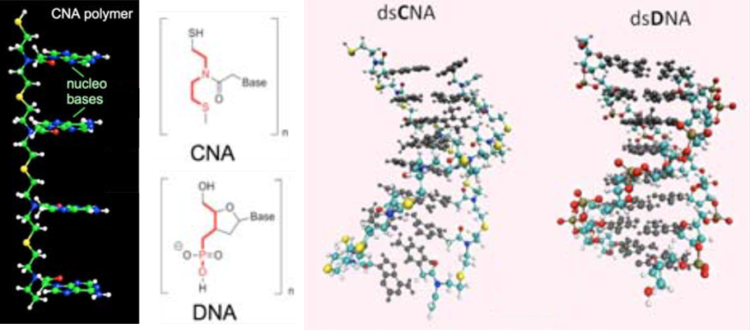
“Imagine a DNA double-helix,” says ChBE Distinguished Professor Chris Bowman. “With its capacity for sequence specific hybridization, DNA exhibits remarkable properties which make it useful for several technological applications. Unfortunately, however, DNA is limited in many ways relative to its potential use in materials applications.”
“Now imagine a DNA analog which is custom-built into the desired structure by ‘clicking’ together nucleobases using simple chemical reactions,” continues Bowman. “At a fraction of the cost of DNA, these Click Nucleic Acids (CNAs) can be used in applications ranging from tissue engineering to drug delivery to self-assembling nano-devices.”
CNAs are one of the two research thrusts of CU’s new Soft Materials Research Center (SMRC). The SMRC, an NSF Materials Research Science and Engineering Center (MRSEC), recently received $12M over six years to advance soft materials in two principal areas: liquid crystals (LCs) and CNAs.
Heading the liquid crystal team is Center Director Noel Clark from the Physics Department; he is joined by a number of collaborators, including ChBE Professors Dan Schwartz and Doug Gin. Their focus is on investigating the phases, structures and molecular-macroscopic relations of LCs for advanced electro-optic, non-linear optic, and sensor applications.
SMRC Associate Director Chris Bowman is leading the CNA effort, joined by a team including ChBE Professors Jennifer Cha (Co-PI), Stephanie Bryant, Charles Musgrave, Prashant Nagpal and Mark Stoykovich. These researchers are exploring sequence-directed self assembly of functional soft materials using CNAs.
CNAs are synthesized by joining monomer base units using photo-initiated thiol-ene click ligation. These clean, robust reactions result in oligomer chains with DNA-style sequences of selected bases. DNA is formed when nucleic acids undergo sequence-directed self assembly (SDSA), wherein the nucleotide bases adenosine (A), guanine (G), thymine (T), cytosine (C), and uracil (U) selectively hydrogen-bond in A-T, A-G, or C-G pairs. CNAs also undergo SDSA, though there is much greater flexibility in controlling the backbone and side chains to tailor molecular functionality and compatibility.
“One of the most compelling aspects of CNAs is their promise to enable SDSA in organic media by exploiting the structural tenability of the chain and base structures,” says Cha. “We can build chains of varying polarity, flexibility, and chemical compatibility.”
The SDSA capabilities of CNAs results in many nanomaterials applications, including directed assembly of nanoparticles, quantum dot constructs, self-assembled DNA/CNA origami, patterning of interfacial molecular networks, the creation of defect-free 3-D ordered frameworks, and asymmetric catalyst development.
Bioscience and biomaterials applications also abound. CNAs enable facile crosslinking with synthetic polymers to engineer capsules for drug delivery or imaging. For instance, SDSA CNA-DNA architectures can be built which release payloads at particular sites in response to DNA-specific enzymes such as nucleases.
CNA hydrogels offer paths to creating robust and flexible platforms for cell encapsulation and tissue engineering. Through thiol-ene chemistry, it is possible to tether any peptide or protein to create environments that promote cell adhesion and spreading and/or to control differentiation.
“We are investigating CNA hydrogels for cartilage, muscle, and stem cell differentiation tissue engineering applications,” says Bryant. “CNA linked hydrogels offer key advantages over conventional covalently crosslinked hydrogels, including more benign crosslinking conditions; more control over the mechanical, swelling and degradation properties of the hydrogel; ability to design CNAs that bind to specific molecules to create stimuli responsive hydrogels; and hydrogels that are mechanically more similar to native tissues.”
This SMRC team is focused not only on developing these CNA applications, but also on creating scalable methods to produce CNAs for materials applications.
“DNA has significant drawbacks that limit its potential applications in materials science. By developing various CNA approaches, we can more readily investigate entirely new ways to use these self-assembling molecules,” says Bowman.
